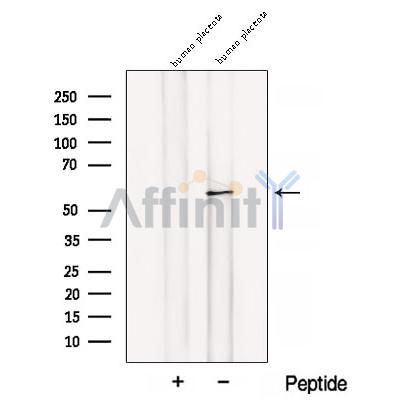BANP Antibody - #DF12849
| 製品: | BANP Antibody |
| カタログ: | DF12849 |
| タンパク質の説明: | Rabbit polyclonal antibody to BANP |
| アプリケーション: | WB IF/ICC |
| 反応性: | Human, Mouse, Rat |
| 予測: | Pig, Bovine, Horse, Rabbit, Dog, Chicken |
| 分子量: | 56 kDa; 56kD(Calculated). |
| ユニプロット: | Q8N9N5 |
| RRID: | AB_2845810 |
製品説明
*The optimal dilutions should be determined by the end user. For optimal experimental results, antibody reuse is not recommended.
*Tips:
WB: For western blot detection of denatured protein samples. IHC: For immunohistochemical detection of paraffin sections (IHC-p) or frozen sections (IHC-f) of tissue samples. IF/ICC: For immunofluorescence detection of cell samples. ELISA(peptide): For ELISA detection of antigenic peptide.
引用形式: Affinity Biosciences Cat# DF12849, RRID:AB_2845810.
折りたたみ/展開
AAH09424; Banp; BANP_HUMAN; BEN domain-containing protein 1; BEND1; BTG3 associated nuclear protein isoform a; Btg3-associated nuclear protein; DKFZp761H172; FLJ 10177; FLJ 20538; FLJ10177; FLJ20538; Protein BANP; Scaffold/Matrix associated region 1; Scaffold/matrix-associated region-1-binding protein; SMAR 1; SMAR1; SMARBP 1; SMARBP1;
免疫原
A synthesized peptide derived from human BANP, corresponding to a region within C-terminal amino acids.
- Q8N9N5 BANP_HUMAN:
- Protein BLAST With
- NCBI/
- ExPASy/
- Uniprot
MMSEHDLADVVQIAVEDLSPDHPVVLENHVVTDEDEPALKRQRLEINCQDPSIKTICLRLDSIEAKLQALEATCKSLEEKLDLVTNKQHSPIQVPMVAGSPLGATQTCNKVRCVVPQTTVILNNDRQNAIVAKMEDPLSNRAPDSLENVISNAVPGRRQNTIVVKVPGQEDSHHEDGESGSEASDSVSSCGQAGSQSIGSNVTLITLNSEEDYPNGTWLGDENNPEMRVRCAIIPSDMLHISTNCRTAEKMALTLLDYLFHREVQAVSNLSGQGKHGKKQLDPLTIYGIRCHLFYKFGITESDWYRIKQSIDSKCRTAWRRKQRGQSLAVKSFSRRTPNSSSYCPSEPMMSTPPPASELPQPQPQPQALHYALANAQQVQIHQIGEDGQVQVGHLHIAQVPQGEQVQITQDSEGNLQIHHVGQDGQLLEATRIPCLLAPSVFKASSGQVLQGAQLIAVASSDPAAAGVDGSPLQGSDIQVQYVQLAPVSDHTAGAQTAEALQPTLQPEMQLEHGAIQIQ
種類予測
Score>80(red) has high confidence and is suggested to be used for WB detection. *The prediction model is mainly based on the alignment of immunogen sequences, the results are for reference only, not as the basis of quality assurance.
High(score>80) Medium(80>score>50) Low(score<50) No confidence
研究背景
Controls V(D)J recombination during T-cell development by repressing T-cell receptor (TCR) beta enhancer function. Binds to scaffold/matrix attachment region beta (S/MARbeta), an ATC-rich DNA sequence located upstream of the TCR beta enhancer. Represses cyclin D1 transcription by recruiting HDAC1 to its promoter, thereby diminishing H3K9ac, H3S10ph and H4K8ac levels. Promotes TP53 'Ser-15' phosphorylation and nuclear accumulation, which causes cell cycle arrest (By similarity).
Nucleus.
Down-regulated in breast cancer cell lines.
Belongs to the BANP/SMAR1 family.
Restrictive clause
Affinity Biosciences tests all products strictly. Citations are provided as a resource for additional applications that have not been validated by Affinity Biosciences. Please choose the appropriate format for each application and consult Materials and Methods sections for additional details about the use of any product in these publications.
For Research Use Only.
Not for use in diagnostic or therapeutic procedures. Not for resale. Not for distribution without written consent. Affinity Biosciences will not be held responsible for patent infringement or other violations that may occur with the use of our products. Affinity Biosciences, Affinity Biosciences Logo and all other trademarks are the property of Affinity Biosciences LTD.


